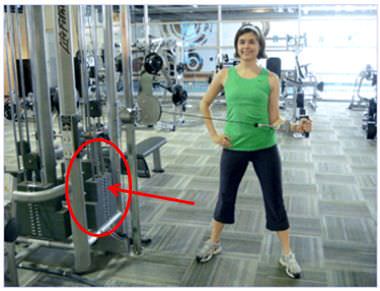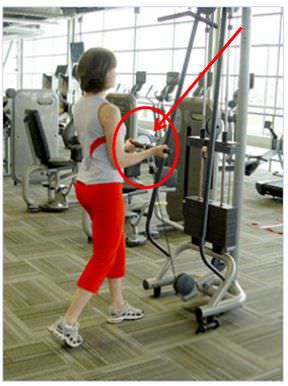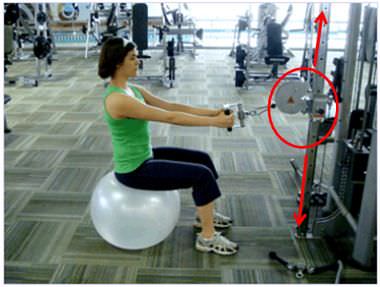|
A few years ago, you would have been more likely to find me in the weight room than on a treadmill. I loved strength training; I would have done it daily (in lieu of cardio) if possible. But something changed more recently that has me enjoying cardio more and strength training less. Maybe I'm getting bored with the weights, machines and same-old exercises after doing some variation of the same moves since I was a teenager. After all, there are only so many ways you can work your biceps. But there is one mode of strength training that I almost always enjoy, even when I don't feel like spending time at the gym. It's the cable cross (or cable "crossover") machine. (It's pictured above.) Most gyms have this universal piece of equipment, but I'd venture to guess that most people aren't sure what it's for or how to use it. In fact, the cable cross may be the most intimidating machines at the gym. Don't let this big machine fool you, however; it's deceptively easy to use. Here are seven reasons you should try it yourself, plus tips and workouts you can start with. It Does Everything. No joke. Name a muscle group or an exercise and you can do with free weights or another machine, and you can do the same thing on the cable cross. It's probably the most versatile piece of equipment in the gym, allowing you to work from multiple angles and directions for endless variety. It's like a one-stop shop to work your muscles! Spend Less Time in the Gym. Because the cable cross can work every muscle in your body in multiple ways, you can save time by strength training with it. Instead of hopping around from machine to machine, setting them up, adjusting the weights and seats, you can stay on one machine and easily change the pulleys or weight stack in seconds, moving from one exercise to the next. This is a great way to circuit train, too. I'll often move from biceps curls to triceps extensions to a lat pull down (all on the cable cross machine) without resting in between. After one set of each, you can go back to the beginning for your second set, eliminating the resting time between each exercise, therefore getting your workout done in less time. Get the Best of Both Worlds. Weight machines are good for beginners, and free weights are more advanced. But the cable cross is sort of a hybrid of the two. It's generally safe, but it's a step up from machines in terms of challenge. If you find the idea of using the free weights in the gym too intimidating for you, the cable cross machine might be the next logical step for you. Work Your Body Unilaterally. A bilateral exercise is one that uses both your right and left side of the body at the same time, such as a standard squat or bench press. A unilateral exercise is one that works one side of your body at a time, such as a single leg squat. Because most people tend to have muscular imbalances between both sides of the body (such as a right leg that's slightly stronger than a left leg), bilateral exercises could allow your weak side to "cheat" (allowing the strong side to do more of the work on a squat, for example). However, if you isolate one side of the body at a time, you can ensure balanced muscular development between both sides of the body. Now, not every cable cross exercise is unilateral, but most of them CAN be. Whether you want to work one arm at a time (such as in this single arm biceps curl exercise) or work both at the same time, using opposite sides of the machine at once (such as this chest fly exercise), you can. That even muscular development can help decrease your risk of injuries related to imbalance, and help you rehab one side of the body that might be weaker due to previous injury. Challenge Your Core. Using a cable cross machine instead of standard gym machines will activate your core muscles (abs, lower back, hips and obliques) more. That's because most gym machines support you and isolate your muscles for you; your body is locked into place passively, without having to work to stay there. Like free weights, you have to do more work to ensure safety and good form when using a cable cross machine. You have to do the work to engage your abs, keep your posture good, stand upright with a long back and avoid leaning while you exercise. All that work to maintain good form means core activation! In addition, you're using more muscle fibers—not just your core—to perform each exercise in good form. That translates to greater challenge and possibly better results, too! Make Old Exercises New Again. Personally, I think the cable cross is fun. It's my go-to machine when I don't feel excited about hitting the gym. Why? It's yet another different way to work out. I like how smooth it feels when I lift and lower the weight. I like that I can flow easily from one exercise to the next. Sometimes just trying something different can make a stale workout fun again. Look Super Cool. The cable cross is a machine that intimidates many people. But when YOU look like you know what you're doing, well, that's pretty impressive! Quickly switching from exercise to exercise and doing moves that trump all the boring machines and exercises you see everyone else doing—that can be motivating to some people. This isn't my main motivation for using the cable cross. But I have to say that I rather feel like a little kid riding my bike with no hands when I use it—like I'm big stuff. "Look what I can do!" These may be good reasons to use it, but I know what you're thinking: How? Here are some tips to get you started.
For a few cable cross workout ideas, check out SparkPeople's Workout Generator. Here are a couple basic upper body and lower body routines you can start with. What do you think about the cable cross machine? Does it seem less intimidating now that you've read this? Are you going to try it? |
Popular EntriesMore From SparkPeople
|




















.jpg)

.png)
.jpg)
